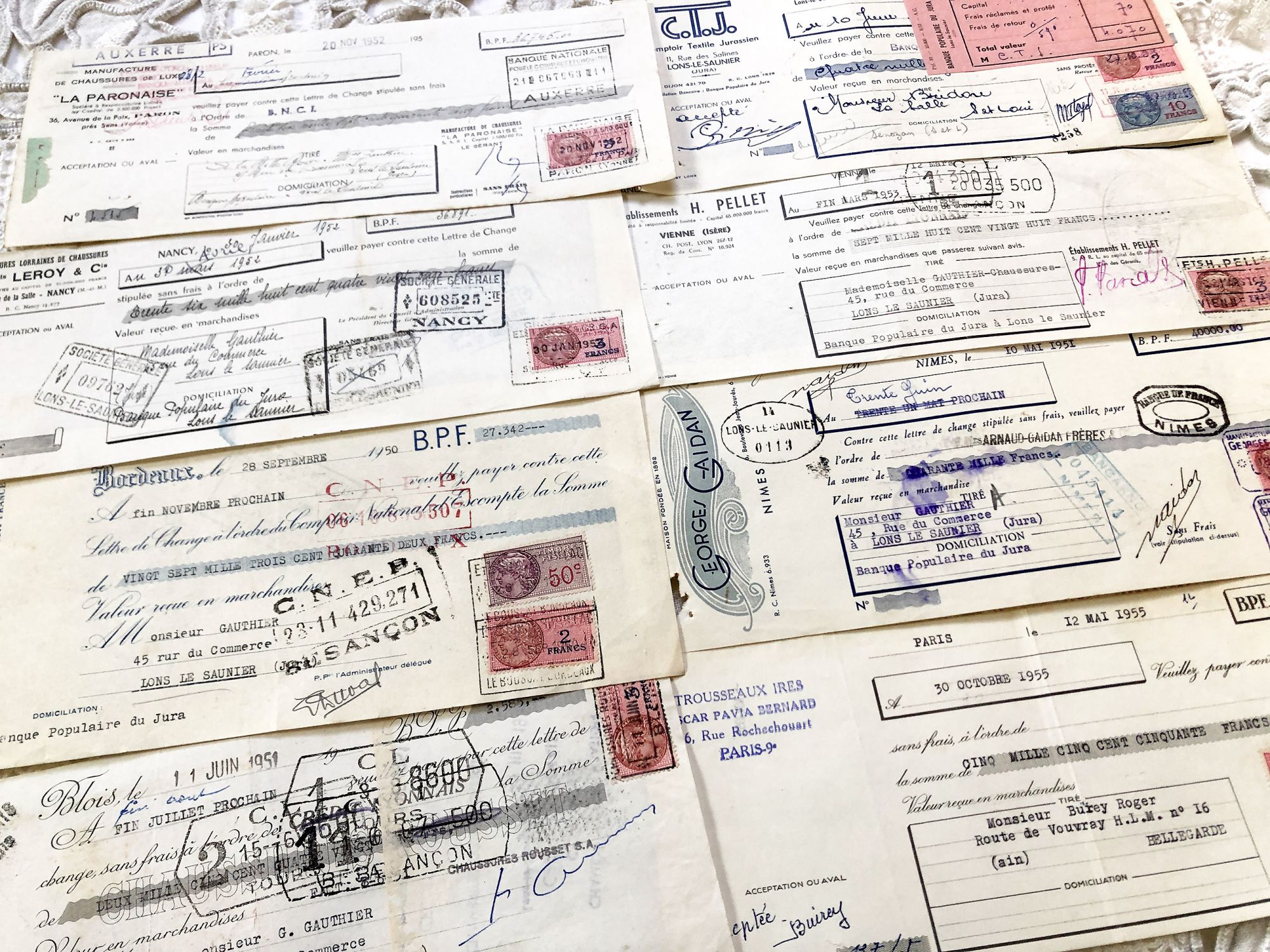
Huge French lottery tickets "Les gueules cassées" from 1936
Huge French lottery tickets "Les gueules cassées" from 1936.
These lottery tickets were sold on the street or in small shops to help veterans.







Set of 8 French bills of exchange from 1950s with tax stamps and rubber-stamps.
Note that several bills of exchange have a hole in the lower left corner: these bills of exchange had to be stapled to the corresponding bills and had to be detached more or less cleanly once the customer had paid the expected amount.
The last photo shows the back of the bills of exchange.
These bills of exchange are financial instruments for loans between companies. Before the massive arrival of computers, these exchanges were carried out by hand as shown by these documents.
Except for digital products, all items are not reproductions, so there may be some wear and tear depending on age what makes it so charming.
Feel free to contact me if you have any questions.
The dimensions and weight of the items offered on this site are expressed in centimeters (cm) and in kilogram (kg).
Here is some information to help you convert them into your own measurement system:
- 10 cm is about 4 inches,
- 1 kg is about 2.2 pounds.
Huge French lottery tickets "Les gueules cassées" from 1936.
These lottery tickets were sold on the street or in small shops to help veterans.
French engraving representing four types of monkey by the drawer Victor Adam dating from the middle of the 19th century.
Jean-Victor Vincent Adam, born in Paris on January 28, 1801 and died in Viroflay on December 30, 1866, is a French painter and lithographer. He has illustrated numerous works and his drawings have been interpreted in engraving by Antoine François Gelée, Émile Giroux and Jean-François Pourvoyeur.
This engraving is probably the result of a reissue of the encyclopedia on wildlife of Buffon.
Huge French lottery tickets "Les gueules cassées" from 1939.
These lottery tickets were sold on the street or in small shops to help veterans.
Set of 20 photos of the city of Verona in Italy in the 1950s.
Verona is a very old Italian town, in the region of Veneto, near Lake Garda.Founded in the 1st century BC, the historic city of Verona experienced periods of expansion in the 19th and 19th centuries and under the Republic of Venice. A remarkable number of ancient, medieval and Renaissance monuments are preserved here. Following the Romeo and Juliet tragedy of William Shakespeare in 1597, whose action is situated in this city, the city becomes the most famous romantic city in the world, called the «city of lovers of Verona».
These photos, linked to each other and folded into a small booklet, are typical of the 1950s and 1960s, during which tourism progressed a lot but not all tourists were equipped with a camera. These photos were sold on the tourist sites allowing everyone to keep a souvenir of the visit.
Vintage Belgian postcard representing a young girl and her mother teaching her to knit sent in 1913. Back probably written in Dutch.
Postcard legend: "Knitting lesson"
Vintage Belgian "Bonne fête" postcard with young girl with a bouquet of flowers from 1910. Back probably written in Dutch.
In Europe and probably in other countries, it is tradition to wish a "bonne fête" to relatives and friends according to their first name and the calendar of saints. It is a tradition dating from the 16th century that lasted until the beginning of the 20th century and is gradually being lost.
English postcard with an illustration by Millicent Sowerby from 1910s
Telegram addressed in 1891 to Georges Coulon President of the French Council of State.
French engraving representing two types of monkeys by the drawer Edouard Travies dating from the middle of the 19th century.
Édouard Traviès de Villers, born in Doullens on March 24, 1809, and died in Paris 5th on November 18, 18761, is a well-known animal painter, illustrator and lithographer. This engraving is probably the result of a reissue of the encyclopedia on wildlife of Buffon.
This postcard was edited by the Parisian Etoile company created by the photographer and industrialist Gaston Piprot, inventor of the patented process "émaillographie". This process gave an incomparable quality of photography for the time as well as a new glazed aspect in the field of the postcard.
Postcard legend: "Je ne sais pas si vous pensez toujours à moi" / "I don't know if you still think about me"
Vintage French postcard representing a young woman with flowers from 1910s. Written back.
Beautiful French letterhead from a soldier send in 1940 to his wife with a 4-leaf clover and a horseshoe, two lucky symbols.
The letter suffered the outrages of time and humidity which also makes it visually beautiful to me
French religious card - First communion card from 1910s
French postcard representing representing two children holding hands with the inscription "Bonne fête" from 1910s. Postcard sent in 1912.
In Europe and probably in other countries, it is tradition to wish a "bonne fête" to relatives and friends according to their first name and the calendar of saints. It is a tradition dating from the 16th century that lasted until the beginning of the 20th century and is gradually being lost.
Four birth announcement cards from 1940s to 1960s and a birth certificate.

Set of 8 French bills of exchange from 1950s with tax stamps and rubber-stamps.
Note that several bills of exchange have a hole in the lower left corner: these bills of exchange had to be stapled to the corresponding bills and had to be detached more or less cleanly once the customer had paid the expected amount.
The last photo shows the back of the bills of exchange.
These bills of exchange are financial instruments for loans between companies. Before the massive arrival of computers, these exchanges were carried out by hand as shown by these documents.
